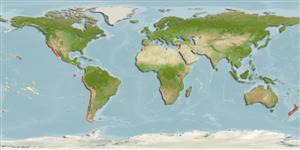Pseudexogone backstromi Augener, 1922
| Native range | All suitable habitat | Point map | Year 2050 |

|
| This map was computer-generated and has not yet been reviewed. |
| Pseudexogone backstromi AquaMaps Data sources: GBIF OBIS |
Загрузить свой Фото
Изображение на Google |
No photo available for this species.No drawings available for Pilargidae.
Изображение на Google |
No photo available for this species.
Classification / Names Common names | Synonyms | CoL | ITIS | WoRMS
| Aciculata | Pilargidae
Environment: milieu / climate zone / depth range / distribution range экология
; пределы глубины 30 - 45 m (Ref. 74514). Tropical
распространение страны | регионы FAO | Ecosystems | места находок | интродукции
Southeast Pacific to Central north Pacific.
Length at first maturity / Size / Вес / Возраст
Maturity: Lm ? range ? - ? cm Max length : 0.9 cm TL самец/пол неопределен; (Ref. 74514)
Depth range or Depth based from holotype (Ref. 74514); to be replaced with a better reference. Assumed maximum length from Ref. 74514.
Life cycle and mating behavior половая зрелость | размножение | нерест | икра | Fecundity | личинки
Members of the class Polychaeta are mostly gonochoric (sexual). Mating: Females produce a pheromone attracting and signalling the males to shed sperm which in turn stimulates females to shed eggs, this behavior is known as swarming. Gametes are spawned through the metanephridia or body wall rupturing (termed as "epitoky", wherein a pelagic, reproductive individual, "epitoke", is formed from a benthic, nonreproductive individual, "atoke"). After fertilization, most eggs become planktonic; although some are retained in the worm tubes or burrowed in jelly masses attached to the tubes (egg brooders). Life Cycle: Eggs develop into trocophore larva, which later metamorph into juvenile stage (body lengthened), and later develop into adults.
Основная ссылка
ссылки | координатор | соавторы
Salazar-Vallejo, S.I., J.H. Bailey-Brock and J.C. Dreyer. 2007. (Ref. 74514)
Статус Красного Списка МСОП (Ref. 130435)
Статус СИТЕС (Ref. 108899)
Not Evaluated
CMS (Ref. 116361)
Not Evaluated
Угроза для людей
Harmless
Использование человеком
| FishSource |
инструменты
дополнительная информация
Возраст/Размеры
рост
Зависимость между длиной и массой тела
Зависимость между длинами
морфология
личинки
численность
рост
Зависимость между длиной и массой тела
Зависимость между длинами
морфология
личинки
численность
ресурсы в Интернет
BHL | BOLD Systems | CISTI | DiscoverLife | FAO(Publication : search) | Fishipedia | GenBank (Геном, Нуклеотид) | GloBI | Gomexsi | Google Books | Google Scholar | Google | PubMed | Tree of Life | Wikipedia (Вперёд, поиск) | Zoological Record
Estimates based on models
Preferred temperature
(Ref. 115969): 15.2 - 22, mean 18.1 (based on 8 cells).


